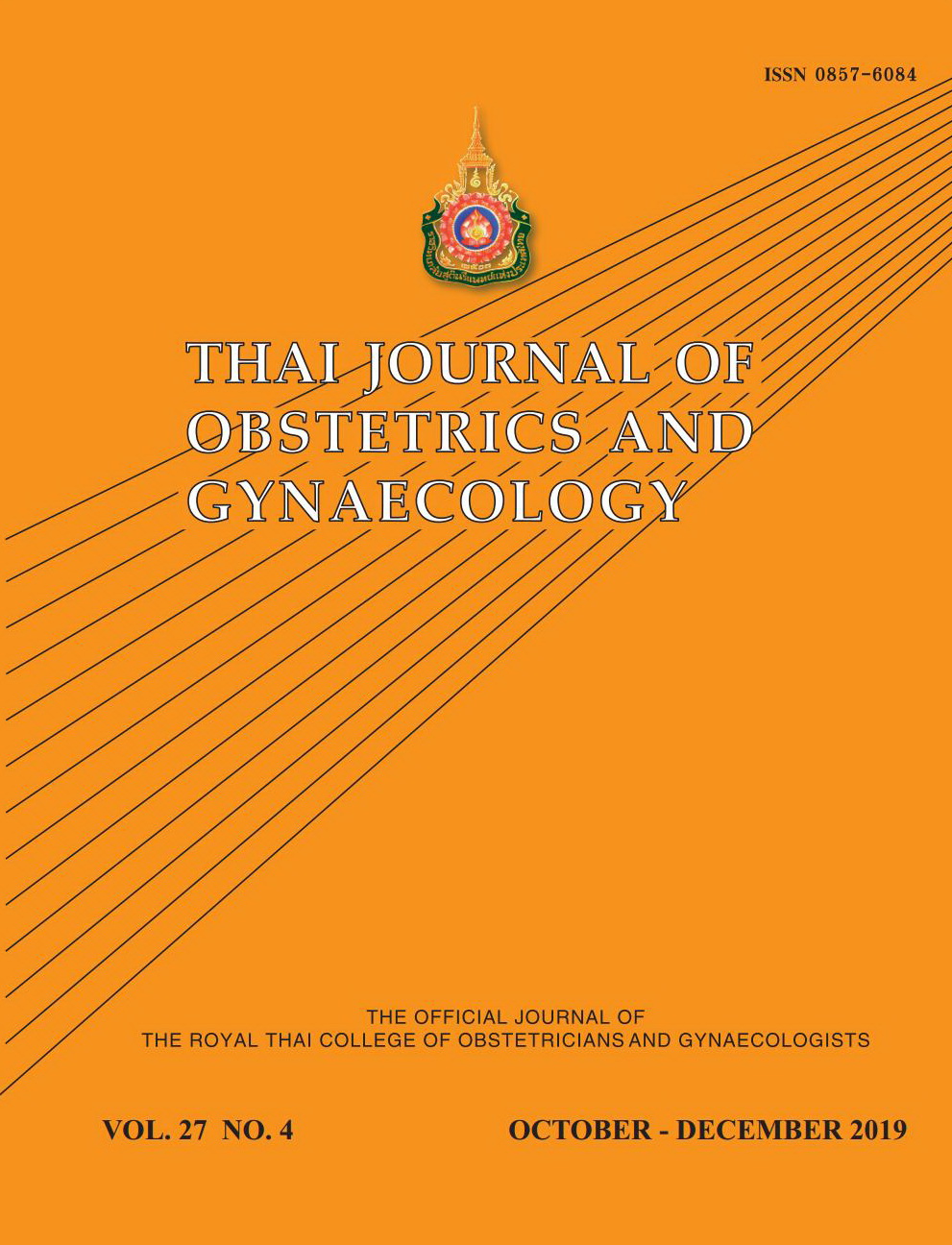Prevalence and Associated Factors of Positive Margins of Cervical Tissue from Loop Electrosurgical Excision Procedure
Main Article Content
Abstract
Objective: Primary objective is to study the prevalence of positive margins of cervical tissue from loop electrosurgical excision procedure (LEEP) for conization and secondary objective is to determine its associated factors.
Materials and Methodss: Medical records of 350 patients who underwent LEEP in Udonthani Hospital form March 2016 to July 2018 were reviewed. Data collection included baseline characteristics, preoperative cytology, colposcopic finding, colposcopic directed biopsy histology, histopathological diagnosis, margin of surgical specimens and all related histologic results. The prevalence and associated factors for positive margins were analyzed.
Results: There were 323 patients who underwent LEEP and had complete data. The mean age was 42.3+10.6 years. The majority of them had a body mass index < 30 kg/m2 (94.1%), multiparous (88.8%), negative test of human immunodeficiency virus antibody (91.3%) and premenopausal status (76.2%). The prevalence of positive margins of cervical tissue form LEEP was found in 80 cases (24.8%), and the most positive margin site was endocervix (48.8%). From multivariate logistic regression analysis, colposcopic directed biopsy histology > cervical intraepithelial neoplasia 2 was the only significant factor associated with the positive margins; adjusted odds ratio 3.91, 95% confidence interval 1.35-11.27.
Conclusion: The prevalence of positive margins of cervical tissue from LEEP was almost one-fourth. The high grade of the colposcopic directed biopsy histology was a significant factor associated with having positive margins.
Article Details
References
2. Chaiwerawattana A, Sangrajrang S, Laowahutanont P, Petrith V. Hospital-based cancer registry Annual report 2015.
3. Nayar R, Wilbur DC. The pap test and Bethesda 2014. Acta Cytol 2015;59:121-32.
4. Massad LS, Einstein MH, Huh WK, Katki HA, Kinney WK, Schiffman M, et al. 2012 updated consensus guidelines for the management of abnormal cervical cancer screening tests and cancer precursors. Obstet Gynecol 2013;121:829-46.
5. Martin-Hirsch PP, Paraskevaidis E, Bryant A, Dickinson HO, Keep SL. Surgery for cervical intraepithelial neoplasia. Cochrane Database Syst Rev 2010;16:CD001318.
6. Arbyn M, Redman CW, Verdoodt F, Kyrgiou M, Tzafetas M, Ghaem-Maghami S, et al. Incomplete excision of cervical precancer as a predictor of treatment failure: a systematic review and meta-analysis. Lancet oncol 2017;18:1665-79.
7. Dou Y, Zhang X, Li Y, Wang F, Xie X, Wang X. Triage for management of cervical high-grade squamous intraepithelial lesion patients with positive margin by conization: a retrospective analysis. Front Med 2017;11:223-8.
8. Chaijindaratana S, Chaisuriyapan T. Prevalence and risk factor of incomplete cervical excision in Chonburi hospital. Thai J Obstet Gynaecol 2013;21:41-8.
9. Chen H, Liu X, Xu L. Incisal margin condition after LEEP for cervical intraepithelial neoplasia patients and prognosis. Exp Ther Med 2016;12:1019-21.
10. Chen Y, Lu H, Wan X, Lv W, Xie X. Factors associated with positive margins in patients with cervical intraepithelial neoplasia grade 3 and postconization management. Int J Gynaecol Obstet 2009;107:107-10.
11. Kietpeerakool C, Srisomboon J, Ratchusiri K. Clinicopathologic predictors of incomplete excision after loop electrosurgical excision for cervical preneoplasia. Asian Pac J Cancer Prev 2005;6:481-4.
12. Liss J, Alston M, Krull MB, Mazzoni SE. Predictors of Positive Margins at Time of Loop Electrosurgical Excision Procedure. J Low Genit Tract Dis 2017;21:64-6.
13. O'Shea AS, Stockdale CK. The impact of LEEP margin status on subsequent abnormal cervical cytology. Proc Obstet Gynecol 2014;4:1-8.
14. Panna S, Luanratanakorn S. Positive margin prevalence and risk factors with cervical specimens obtained from loop electrosurgical excision procedures and cold knife conization. Asian Pac J Cancer Prev 2009;10:637-40.
15. Tanompongchat R, Sangkarat S, Padungsutt P. Prevalence and risk factors of LEEP margin involvement. Thai J Obstet Gynaecol 2003;15:153-9.
16. Daniel WW. Biostatistics: A Foundation for Analysis in the Health Sciences (Probability & Mathematical Statistics). 6th ed: John Wiley & Sons, New York 1995.

